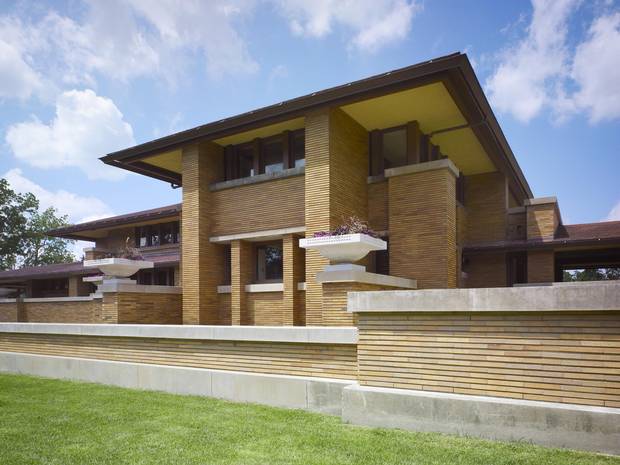"Don't freeze your architect down to certain areas," wrote Frank Lloyd Wright. "Proportion must determine these things within reasonable limits, and give him a free hand within that limit; stretch the limit until your discretion deflects to the breaking point."
That was the great architect writing in 1904 to Darwin D. Martin, the Larkin Soap Company executive for whom he was designing a house. Martin sure didn't "freeze him down": The house Wright designed for him is both enormous and spectacular, a 15,000-square-foot mansion as fine as any in North America.
And here I was, inside the place. Moving from the foyer of the deep-eaved house, through rooms lined with elaborate stained glass, Roman brick, and oak cabinetry, I stepped through a low doorway and looked down a 100-foot-long pergola toward lush plantings and a statue of a goddess.
Reconstructed and restored, the Martin House is a masterpiece of 20th-century building. And it's in Buffalo.
Yes, Buffalo, N.Y.: the American city less than two hours from Toronto, best known to Ontarians for cross-border shopping and fiery TV newscasts. Yet the city was once among America's richest, and it has a tremendous wealth of architecture, urbanism and art. It was here that I came to mark the 150th birthday of Wright – and here that he did some of his great work.
The Martin House complex is the best place to encounter Wright's legacy. Designated as a National Historic Landmark in the 1980s, it's one of the grandest houses in the Prairie Style, which Wright defined in Chicago in the years after 1900.
Buffalo is not on the prairie, but that didn't stop Wright, a relentlessly prolific designer and unstoppable self-promoter, from elaborating its ideas: strong horizontal lines; long roofs with shallow slopes; sheltering overhangs at every turn; and the use of natural materials. Warm-hued Roman brick and stained, rift-cut white oak define the interiors – along with elaborately crafted windows and mosaic. At a glance, it's easy to confuse the house's interior for what we now call "traditional" home design. But Wright was a radical; his designs aimed to break the vertical, formal and front-facing conventions of domestic North American architecture. That long view through the pergola will stretch the limits of what you expect in a house.
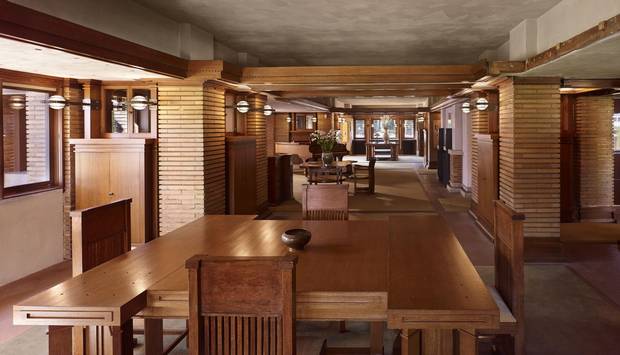
The Martin House is one of the grandest houses in the Prairie Style.
Biff Henrich/Martin House
The Martin complex, after decades of neglect, is completing a restoration at a cost of more than $40-million (U.S.). The excellent architect Toshiko Mori completed a fine minimalist visitors' centre in 2009. The pergola, conservatory and a carriage house, all demolished, have been reconstructed with elaborate care, and the landscape is being reconstructed – restoring the complex to Wright's original, grand vision. "It's one of the most comprehensive, well-thought-out compositions that Wright ever did," says Mary Roberts, executive director of the Martin House. "It's a microcosm of Wright's ability to design both grand and modest homes in the same location," combining "buildings, landscapes, art glass and furniture."
That grand vision was typical of Wright, who had a career that stretched from the early days of the skyscraper in Chicago to the curvaceous Guggenheim Museum in New York in 1959. An exhibition at the Museum of Modern Art in New York is re-examining his ideas, from handcraft to the shape of the cities of the future. The Martin House is a fine place to get a taster of those ideas; and just outside Buffalo, Graycliff – the Martin family's summer house, completed in 1928 – offers its own, more modest window on the architect.
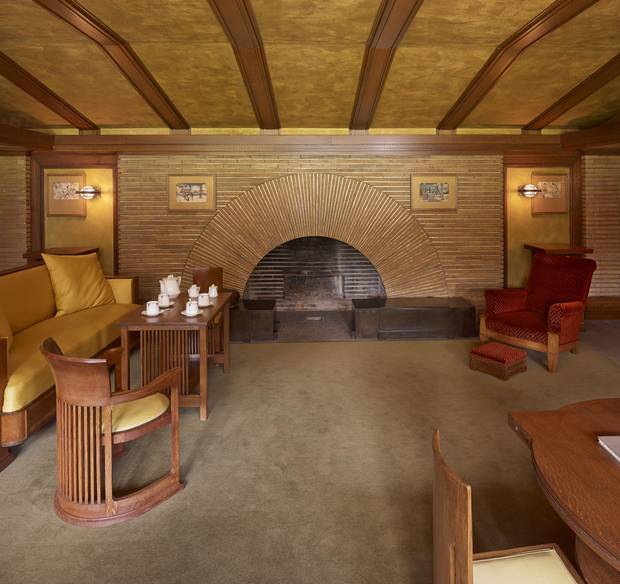
The reception room at the Martin House.
Biff Henrich/Martin House
But that's only the beginning of Buffalo's cultural offerings. The Albright-Knox Gallery has one of North America's finest collections of modern art, and yet its complex, a Beaux-Arts temple and a 1962 modernist pavilion by the eminent architect Gordon Bunshaft, is amazingly uncrowded. You can visit with MOMA-worthy blockbuster modern paintings – over here a Rothko, there a Franz Kline, there an amazing Pollock – yet have enough time and space to see them.
The city's architectural legacy, even beyond Wright, is likewise extraordinary. A system of city parks and parkways was defined by Frederick Law Olmsted, the designer of New York's Central Park, and Calvert Vaux; while this legacy is somewhat compromised now (by a golf course, for one thing), much of the network remains intact, and the surrounding areas of the city remain incredibly picturesque.
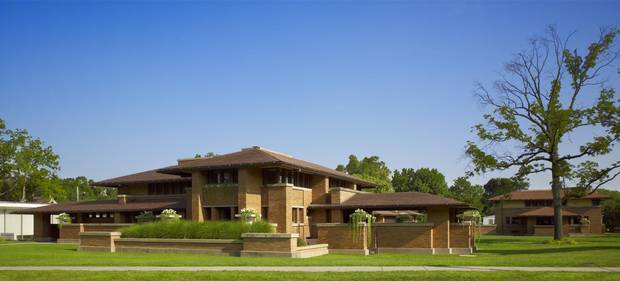
Wright’s designs aimed to break the vertical, formal and front-facing conventions of domestic North American architecture.
Martin House
Downtown, I took a tour with Brad Hahn of Explore Buffalo, a local non-profit; Hahn expertly led me past the grand Art Deco City Hall, a hulking Brutalist courthouse, and Daniel Burnham's grand Ellicott Square – stopping at Louis Sullivan's 1895 Guaranty Building to admire one of the great early skyscrapers, its walls rich with terra cotta ornament.
The 1880 Richardson Olmsted Complex is the latest addition to Buffalo's architecture-tour itinerary. It was designed by the architect H.H. Richardson, whose muscular version of the Romanesque style was fashionable in the 1880s and 1890s – shaping Toronto's Old City Hall and Queen's Park. Here, Richardson was designing a psychiatric hospital, its huge scale providing the light and fresh air that were thought to be therapeutic. Now one-third of the complex has been renovated. Its sandstone walls and grand proportions make it a sympathetic home for the newly opened Hotel Henry and associated, good restaurant.
Not all of Buffalo has been cleaned up, though. Take its downtown collection of grain elevators, which speak to the source of the city's wealth at the end of the Erie Canal, linking the agricultural Midwest to New York City. Long seen as simply obsolete, these not pretty-but-sublime industrial monoliths are finding new life. Riverworks, which opened this spring, converts a set of elevators into a brewery, beer garden and entertainment venue. I went rock climbing inside the echoey depths of a silo that felt remarkably untouched.
And there's something to that: If the work of Wright and Richardson can be carefully revived, there's also beauty in seeing relics that haven't been retouched. I found some at Silo City, a collection of grain elevators that have not been turned into anything much. Local entrepreneur Rick Smith offers tours and kayaking trips, but his main interest is in using the silos for music, dance, theatre, literary readings and art installations; when I visited, the Canadian artist Gareth Lichty had taken over one of the silos for a dramatic installation of multicoloured tape. Smith showed me a new bar, fitted out with salvaged wood and steel, that will open this year; it will be handsome but hardly slick. For now, Silo City – and Buffalo – remain a fine place to think about the ups and downs of cities, to observe the most refined artistry of the last century, and to explore its amazing castoffs.
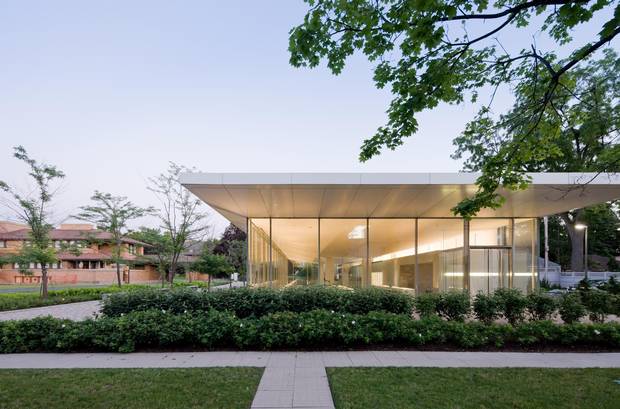
Greatbatch Pavilion at the Martin House.
Iwan Baan/Martin House
Where to Stay
Hotel Henry
Eighty-eight guest rooms range from $160 (U.S) a night for a queen room to $350 a night for suites, excluding taxes and fees; Hotel Henry offers a direct-booking discount to guarantee the lowest room rate when you book directly with the hotel.
444 Forest Avenue,
hotelhenry.com
Where to Eat
100 Acres
Sprawling through the corridors of Hotel Henry, it focuses on small plates and regional sourcing.
100acresbflo.com
The Terrace at Delaware Park
Informal but excellent dining in the middle of Olmsted's Delaware Park; 199 Lincoln Parkway.
terracebuffalo.com
Five Points Bakery
An atmospheric space on the city's west side, where they are serious about toast; 44 Brayton Street.
fivepointsbakery.com
The writer was a guest of the Martin House. It did not review or approve this article.
